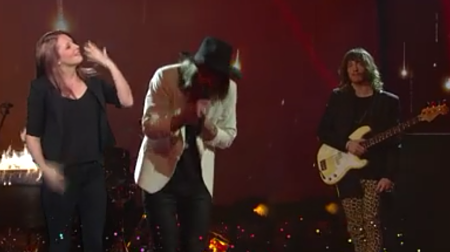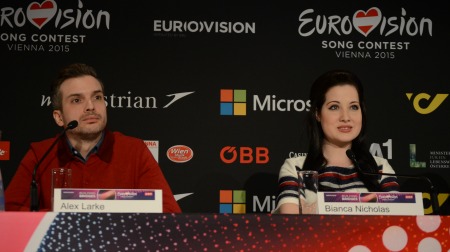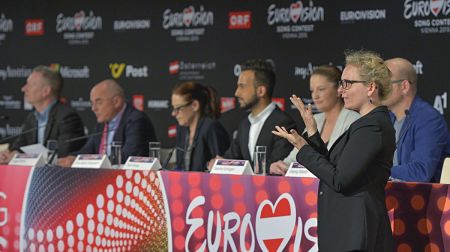During the joint ORF/EBU Press Conference at the 2015 Eurovision Song Contest on Monday 18th May, we heard that the EBU had teamed up with host broadcaster ORF to produce sign language editions of the 2015 Eurovision entries and broadcast these live on a separate stream online. Ben Robertson looks deeper into this to establish the history of sign language at the Eurovision Song Contest and at what the team from ORF hope to achieve with this new Song Contest innovation.
What Is Happening And Where You Can Watch
ORF, the Austrian broadcaster in charge of producing the Eurovision Song Contest this year, has been granted permission to broadcast the Eurovision Song Contest in International Sign. This will be broadcast through a total of eight participating countries and also will be available internationally for one week through ORF’s web stream. ORF 2 Europe will broadcast the sign language show of the Grand Final across the continent. Eurovision.tv should be broadcasting this live through their web player as well.
Each show is going to be broadcast live with a team of interpreters explaining their way through the show, with the performances being pre-recorded and set aside the stage show with green screen technology. The concept they are going for is ‘interpretive sign’, meaning the acts are not just going to be translating the entries but also ‘visualising the emotion behind the lyrics and the music’ as charming sign language interpreter Delil Yilmaz explained.
To get an idea of what to expect, their one minute introductory video is available to view online.
Sign Language At Eurovision In The Past
This will not be the first time sign language has been seen at the Song Contest, but to many a Eurovision fan the utterance of it in context with the stage show will spark horror thoughts of cheesy entries from years gone by. Notable appearances include that from Latvia’s 2005 entry ‘The War Is Not Over’ and also Lithuania’s ‘C’est Ma Vie’ from the 2011 Contest in Germany. However what broke the boundaries of sign language beyond what some may ridicule as a gimmick to one of value goes back to Loreen in 2013. After winning Eurovision, Loreen performed an reprise of ‘Euphoria’ both at Melodifestivalen and Eurovision with a group of children performing sign language to her winning entry.
What is notable here is that this was not being done as a tactic to try and get more votes in the Song Contest. With this performance the tone was more about appreciation of the artform and the inclusion of a minority which finds it impossible to access the melody of music, but can still connect to the emotions behind it. Furthermore, sign language and Eurovision were married together again this year, as Magnus Carlsson found himself the centre of a PR wonder after his Melodifestivalen entry, ‘Möt Mig i Gamla Stan’, was accompanied by Swedish sign interpreter Tommy Krångh. These performances combine the classical movements to translate the words of the song with the emotions felt, by using their whole body and face to demonstrate the mood of the music and performance on stage.
Making This Project A Reality
The ideas for creating this concept started off well before Tommy’s viral video, with Eurovision Sign Manager Eva-Maria Hinterwirth explaining how the planning for this came soon after the Contest was confirmed to come to Vienna last year. The steps involved required deaf interpreters to be found who could also work alongside music, and also those who were able to learn International Sign. International Sign differs from Austrian Sign Language, British Sign Language, and others as it is not a recognised language in any way and works without following any grammatical rules. Instead, it is a language based more around body movements and expressions, making it the perfect thing to use interpretively at Eurovision.
The hard graft has been done by Dilal Yilmaz. Speaking at the Press Conference he explained a complex process to create each performance. The team have been working for the last few weeks to do the training needed to make each performance effective.
It would take between 6 to 10 hours to create one performance. The longer ones are those that are performed into their native language. From their language we have to translate to German, then to Austrian Sign Language and finally to International Sign. From International Sign we have to make a story that fits the rhythm and the character, there is the so called constructed action.
In the United Kingdom entry, for example, during the intro of the song, the first 15-20 seconds, there is only music, some violins, drums etc. Well we didn’t sign “piano”, “violin”, it’s not necessary. We work with storytelling. What is the song about? The UK song is about love. Love is the main topic. What is the connection between the two people? The guy is more macho and the girl, she just wants to be pretty.
Issues Arising With The Contest’s New Language
There was also the difficulty in getting the different broadcasters around the EBU to agree to this venture, with only nine countries partaking in the broadcast themselves this week. Jon Ola Sand believes very much in the project, describing it as a ‘great idea’ and something ‘in the core of public service broadcasting’ during the Press Conference. However, the pitfalls that have arisen have come from trying to convince different broadcasters to take up the project and allow it to continue. It is easy to see why, as the interpretation of the performance is being done by the sign language experts themselves, and may be at odds with the mood that each entry wants to create. Leaving this artistic interpretation of the performance being out of the hands of each individual broadcaster may not be considered fair. I put this to Eva during our interview.
When we make the storytelling we knew that we are doing interpretation. When you read a poem, the emotion that hits you is different to the emotion I have to when reading the poem. We stick to the context of the song but we translate that into deaf culture. I am very proud that they (the EBU) trusted us completely.
Furthermore, an added concern is that it makes stars out of our sign language interpreters more than our artists themselves. The BBC interview above reported how Tommy Krångh ‘upstaged’ Magnus Carlsson, and although it was all good fun extra caution needs to take place in the complex minefield of the Eurovision Song Contest. Together with Eva, Delil and non-hearing interpreter Alice from China we watched and discussed Magnus Carlsson’s Melodifestivalen performance. The team are going for a slightly different approach than what Tommy did as Eva explained.
We feel the hype behind that song was great. We even saw it in Tokyo this year. What the sign performers are doing is to spread the message, but we have different approaches. We have to make sure we are not stealing the show. We are doing our job and the performance is for deaf people, they are the target audience. Most of the time hearing people just get overwhelmed and think what the hell is this? What are they doing? This is a means of communication, and that is what we feel through the performance.
Alice is able to spot some more technical aspects that demonstrate what will be different further.
I’m deaf and my mother language is sign language, I can see that he is translating, I can see that his mouth is moving and he is singing, he could have a microphone. He has charisma, but it’s not that interesting to me.
I put it to Alice that her performances could also have the same effect after the Song Contest.
For deaf people I think it would be very good. We make sure to put deaf culture, not hearing culture, into the songs. He is very dominant in this video, you focus on the interpreter and not the singer, and the singer should be the star. We are more on the left or right of the screen rather than being in-front of the shot.
It would be easy to have a cynical hat on here, and easy to say that this would be a cheap win for the Eurovision Song Contest to get more publicity. That is not the aim here; this is a genuine attempt to make Eurovision a more open Contest, not for any of the people here to take the focus away from the artist’s three minutes on stage. This is serious, this is sustainable and this is a great project to combine bring Eurovision to more people.
Why It Should Be Embraced
That ORF are including such a step in the modern Eurovision Song Contest fits into their motto of “building bridges” and continues to demonstrate how the Song Contest can always be a testing ground for new broadcasting ideas. We should treat a new movement like this as a challenge to broadcasting, just like the challenges of connecting a huge kinetic structure to the rigging of the Stadthalle, but one with benefits that go beyond pure technical improvements and welcomes so many more to the glitz and glamour.
The inclusion of interpretive sign may be a direct effect of the viral impact Melodifestivalen achieved this year, and how Eurovision wants to bounce itself into social media. However, speaking to the people behind this it is quite clear that we are talking about something far more serious, with a team behind the sign language clear that this is not about attention seeking, this is making Eurovision welcoming to the deaf community. If it can work at Eurovision, of course the benefits adapting the process to other events could also be great.
This is about raising awareness and normalising the culture of the hearing impaired to make Eurovision more inclusive. It is a positive step in creating a culture where all are welcome to be a part of the fantastic world of the Eurovision Song Contest, and one that we would hope would continue on in future editions as well.












